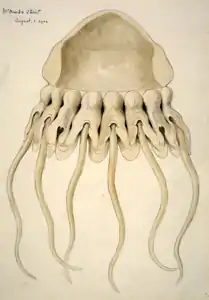Helmet jellyfish
The helmet jellyfish (Periphylla periphylla) is a luminescent, red-colored jellyfish of the deep sea, belonging to the order Coronatae of the phylum Cnidaria. It is the only species in the monotypic genus Periphylla.
| Helmet jellyfish | |
|---|---|
 | |
| Scientific classification | |
| Kingdom: | Animalia |
| Phylum: | Cnidaria |
| Class: | Scyphozoa |
| Order: | Coronatae |
| Family: | Periphyllidae |
| Genus: | Periphylla F. Müller, 1861 |
| Species: | P. periphylla |
| Binomial name | |
| Periphylla periphylla (Péron & Lesueur, 1810) | |
Reproductive cycle
P. periphylla represents an exception, very rarely found in the phylum Cnidaria: the medusae do not go through a polyp stage, thus presenting a "holopelagic" life cycle. The medusae release fertilized eggs in open water and these develop directly into medusae, whose development rests entirely upon the egg's high yolk supply. The ephyra stage common among other jellyfish is not observed in P. periphylla.
Life style
The jellyfish is found in depths up to 7,000 m (23,000 ft) and is adapted to its dark environment.
At night, the helmet jellyfish leaves the depths and swims up toward its food, zooplankton. With a full stomach it turns from the surface back to the depths. Other deep-sea inhabitants feed upon its faeces.
Description
Helmet jellyfish reach a body size of up to 30 cm (12 in). They consist 90% of water, the rest being tissue and gelatinous mass, which give the animals their form. They light themselves from within by means of bioluminescence, the red flashes serving as a signal amongst themselves. Between their marginal lobes sit small sense bulbs, by which the helmet jelly can distinguish between light and dark; they have been observed to avoid light.
Distribution
The helmet jelly is found in every ocean of the world, as well as in the Norwegian fjords and in the Mediterranean Sea.
Current ecological problems
In many fjords of Norway the helmet jelly has proliferated since the 1970s. It has become a competitor of fish for food and is thereby also a threat for the fishing industry. Not far from Bergen, in the Lurefjord, helmet jellies have proliferated.
Bibliography
- Youngbluth, Marsh J.; Båmstedt, Ulf (2001), "Distribution, abundance, behavior and metabolism of Periphylla periphylla, a mesopelagic coronate medusa in a Norwegian fjord.", Hydrobiologia, 451: 321–333, doi:10.1007/978-94-010-0722-1_27
- Jarms, G.; Tiemann, J.; Båmstedt, U (2002), "Development and Biology of Periphylla periphylla (Peron & Lesueur, 1809) (Scyphozoa, Coronatae) in a Norwegian Fjord", Marine Biology, 141 (4): 647–657, doi:10.1007/s00227-002-0858-x
- Kaartvedt, Stein; Klevjer, Thor A; Torgersen, Thomas; Sørnes, Tom A; Røstad, Anders (2007), "Diel vertical migration of individual jellyfish ( Periphylla periphylla )", Limnol. Oceanogr., 52 (3): 975–983, doi:10.4319/lo.2007.52.3.0975, JSTOR 4499670
- Sornes, T.A.; Hosia, A.; Båmstedt, Ulf; Aksnes, D.L. (2008), "Swimming and feeding in Periphylla periphylla (Scyphozoa, Coronatae)", Marine Biology, 153 (4): 653–659, doi:10.1007/s00227-007-0839-1, PMC 6182610